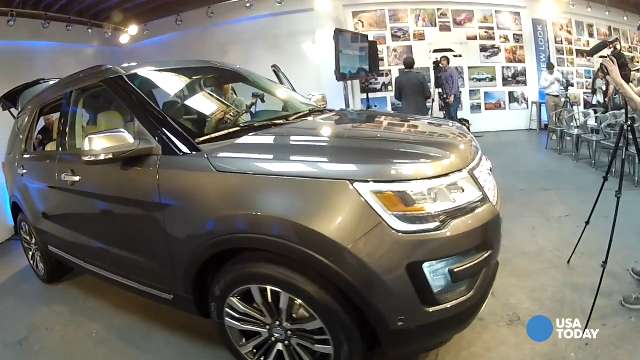 What was the car's make and model?
What was the car's make and model?
The original car was a 1961 Lincoln Continental 4-door convertible.
Why was it called "X-100"?
X-100 was the code name given to the car by the Secret Service.
Who built the car?
Ford
Motor Company assembled the car at its Lincoln plant in Wixom, Michigan
in January 1961. Hess & Eisenhardt of Cincinnati, Ohio was
responsible for customizing the car to function as a presidential parade
limousine, literally cutting it in half, reinforcing it, extending it 3
½feet in length, and making numerous other modifications. Ford Motor
Company and Hess & Eisenhardt collaborated on engineering and
styling. It debuted at the White House in June 1961. The car remained
the property of the Ford Motor Company, which leased it to the Secret
Service for the nominal price of $500 per year.
What did the car cost to build?
The
car, as equipped at the Lincoln plant, would have retailed for $7,347.
Custom built, the car cost nearly $200,000, according to Randy Mason
("The Saga of the 'X-100'").
What were some of the car's special features?
Special features on the 1961 limousine included:
- Removable steel and transparent plastic roof panels
- Hydraulic rear seat that could be raised 10½ " to elevate the president
- Massive heating and air conditioning system with auxiliary blowers and 2 control panels
- Dark blue broadcloth lap robes with gray plush lining and hand-embroidered presidential seals in special door pockets
- Four retractable steps for Secret Service agents
- Two steps on rear bumper for additional agents
- Flashing red lights, siren
- Blue Mouton rug in rear
- Indicator lights when door was ajar or steps out
- Two flagstaffs, two spotlights
- Auxiliary jump seats for extra passengers
- Two radio telephones
- Interior floodlights
In
1963 the car's grille was replaced by one from a 1962 model and
'sombrero'-style wheel covers like those of the 1957 Lincoln Premiere
were added. Trunk lid grab handles for Secret Service agents were
affixed as well.
What happened to the car after President Kennedy's assassination?
The
X-100 was impounded for evidence in the weeks following the
assassination on November 22, 1963. Soon after plans were made to modify
the car in Cincinnati, Ohio and then return it to Washington D.C.
What was "Project D-2" or the "Quick Fix"?
Following
the assassination of President Kennedy, a committee was formed
(originally comprised of thirty people) of six people representing the
Secret Service, Army Materials Research Center, Hess & Eisenhardt
and Pittsburgh Plate Glass Company. The White House approved a plan for a
revamp of the X-100 around December 12, 1963. Work was completed May 1,
1964 and extensive testing was performed in Cincinnati, Ohio and
Dearborn, Michigan before the car was delivered to the White House in
June. Costs have been estimated to exceed $500,000 and were shared by
Ford Motor Company, some Ford suppliers and the federal government.
Basic elements of the revamp included:
- Complete re-armoring of rear passenger compartment
- Addition of permanent non-removable top ("greenhouse") to accommodate transparent armor
- Replacement of engine with hand-built, high compression unit, providing approximately 17 percent more power
- Addition of second air conditioning unit in trunk
- Addition of certain electronic communication devices
- Reinforcement
of some mechanical and structural components, e.g. front wheel spindles
and door hinges, to accommodate additional weight
- Complete re-trimming of rear compartment, eliminating damage resulting from the assassination
- New
paint treatment, "regal Presidential Blue Metallic with silver metallic
flakes that glitter under bright lights and sunshine" (May 1, 1964
report by Willard C. Hess of Hess & Eisenhardt)
What was "Project R-2"?The X-100 underwent major modifications again in January 1967. These were also completed by Hess & Eisenhardt and included:
- Revision of air conditioning system for greater cooling capacity
- Conversion
of right rear door, which had been 1 13/16” bullet-proof glass, to
drop-glass actuated by heavy duty power regulator assembly
- Reinforcement of deck lid with fiberglass to accommodate additional weight
- Stripping of entire car to bare metal in order to remove dents and repaint body
- Minor changes, such as addition of roof mounted grab handles
In
the following ten years, other minor modifications were made as well.
Front bumper guards were added and their built-in red flasher lights
were replaced with red lights in the grille. During President Nixon’s
stay in office, the large one-piece glass roof was replaced with one
with a smaller glass area and a hinged panel. This would permit the
president to stand during parades.
When was the car retired?
Although
other presidential parade cars were built in 1968 and 1972, it was used
occasionally by Presidents Johnson, Nixon, Ford and Carter. The X-100
remained in service until early 1977. The car is now exhibited to the
public at the Henry Ford Museum in Dearborn, Michigan.
Source:
thehenryford.org
Images:


























